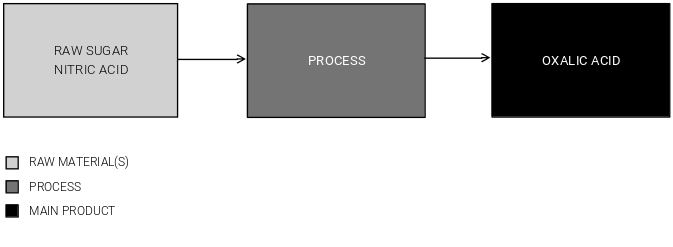Commodity Production Costs Report
Oxalic Acid Production
Oxalic Acid Plant Capital & Operating Cost Analysis | United States | Q3 2025
This report presents the economics of Oxalic Acid from sugar and nitric acid. The process examined is a typical oxidation process. In this process, sugar is hydrolyzed into glucose and fructose, which are oxidized to Oxalic Acid by a nitric-sulfuric acid mixture.
The report provides a comprehensive study of Oxalic Acid production and related Oxalic Acid production cost, covering three key aspects: a complete description of the Oxalic Acid production process examined; an in-depth analysis of the related Oxalic Acid plant capital cost (Capex); and an evaluation of the respective Oxalic Acid plant operating costs (Opex).
The Oxalic Acid production process description includes a block flow diagram (BFD), an overview of the industrial site installations, detailing both the process unit and the necessary infrastructure, process consumption figures and comprehensive process flow diagrams (PFD). The Oxalic Acid plant capital cost analysis breaks down the Capex by plant cost (i.e., ISBL, OSBL and Contingency); owner's cost; working capital; and costs incurred during industrial plant commissioning and start-up. The Oxalic Acid plant operating costs analysis covers operating expenses, including variable costs like raw materials and utilities, and fixed costs such as maintenance, labor, and depreciation.

Product
Oxalic Acid. Oxalic Acid (a.k.a. Ethanedioic Acid) is the simplest dicarboxylic acid. It forms a colorless crystalline solid that, when dissolved in water, forms a colorless solution. Oxalic acid is available commercially as the dihydrate. It occurs naturally in plants and vegetables and it has important roles in human, plant and algal metabolism. Oxalic Acid is a strong reducing agent.
Raw Materials
Raw Sugar. Raw sugar is a commodity product which is light brown in color and presents from 96 to 99 wt% of sucrose. Since it is not an edible product, it must undergo a refining process to become a refined sugar (more than 99.9 wt% sucrose), a product suitable to food applications. This may be accomplished in the same sugar factory where raw sugar was produced or in stand-alone refineries. It is commercialized as a granular product, and can be produced either from sugarcane or sugarbeet, depending on climate conditions. Sugarcane is cultivated in tropical and subtropical areas, while sugarbeet is more suitable to temperate zones.
Nitric Acid. Nitric acid is a strong oxidizing acid used in the production of fertilizers, explosives, and in various chemical syntheses. It also plays a critical role in metal processing and the production of nitrates. Nitric acid is produced by oxidizing ammonia via the Ostwald process and is stored as a liquid. Its ability to act as both an oxidant and a nitrating agent makes it a key component in the production of ammonium nitrate for both agricultural and industrial applications.
Report in PDF Format
Download & Explore Anytime
Access in Various Devices
Print & Read Comfortably
Share With Co-workers
Up-to-date Report
Professional report based on Q3 2025 economic data, ensuring timely evaluations.
Multiple Use Cases
Ideal for investment screening, feasibility studies, cost estimates, and research planning.
Proven Methodology
Developed using a consistent methodology honed over a decade, ensuring reliable cost analyses.
Report Editions
Content Highlights
Plant Capital Cost Summary
Summary outlining the capital cost required for building the Oxalic Acid production plant examined.
Plant Capital Cost Details
Detailing of fixed capital (ISBL, OSBL & Owner’s Cost), working capital and additional capital requirements.
Plant Cost Breakdowns
Breakdown of Oxalic Acid process unit (ISBL) costs and infrastructure (OSBL) costs; plant cost breakdown per discipline.
Operating Costs Summary
Summary presenting the operating variable costs and the total operating cost of the Oxalic Acid production plant studied.
Operating Cost Details
Detailing of utilities costs, operating fixed costs and depreciation.
Plant Capacity Assessment
Comparative analysis of capital investment and operating costs for different Oxalic Acid plant capacities.
Production Process Information
Block Flow Diagram, descriptions of process unit (ISBL) and site infrastructure (OSBL).
Process Consumptions
Raw materials and utilities consumption figures, by-products credits, labor requirements
Process Diagrams
Process flow diagrams (PFD), equipment list and industrial site configuration
Could Not Find the Report You Need?
Obtain a Bespoke Report
Get a report targeting the process in which you are interested
See Offer Details
Understand Bespoke Reports and how you can easily order them
Check Editions & Pricing
Complete a brief form and see a quotation for your Bespoke Report
Other Related Production Cost Reports

Weak Nitric Acid from Ammonia (Dual Pressure Process)
In this report, it is approached the economics of Weak Nitric Acid (65 wt%) production from ammonia in a typical dual pressure process, assuming an industrial plant located in the United States. Initially, ammonia is oxidized to nitric oxide at medium pressure. Then, nitric oxide is oxidized to form nitrogen dioxide, and absorbed at high pressure by water producing nitric acid.
Details: 250 kta United States-based plant | Q3 2025 | 107 pages | Issue C | From $799 USD

Concentrated Nitric Acid Production from Weak Nitric Acid
This study presents a feasibility analysis of Concentrated Nitric Acid (99 wt%) production from weak nitric acid (65 wt%) by extractive distillation using sulfuric acid as dehydrating agent. The economic analysis assumes a plant constructed in the United States.
Details: 250 kta United States-based plant | Q3 2025 | 107 pages | Issue E | From $799 USD
+800 Reports Developed, Targeting +250 Commodities
Vast Report Library
858 independent and up-to-date reports examining embryonic and established production processes.
Free Sample Reports
Quickly understand the structure and depth of content of our professional reports.

